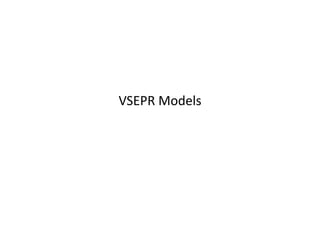
VSEPR Models Explained
- 1. VSEPR Models
- 2. Purpose • Now that you know how to draw dot diagrams, we will translate them into shapes for the molecules called molecular geometry. This will ultimately allow us to understand properties of the substances. For example, if the water molecule was linear rather than bent, much of the water on earth would vaporize since the boiling point of water would drop significantly. Similarly, the function of proteins in our body is dependent on the shape of the protein, which is determined from the arrangements of the bonds in the protein molecule.
- 3. Example – H2O • We will start with water as an example here. The water molecule has a bent geometry with the hydrogens with an angle of 104.5o between them. We need to understand why water takes this geometry. H H O
- 4. The Big Idea – Valence Shell Electron Pair Repulsion (VSEPR) • Pairs of electrons whether bonding or non-bonding will try to get as far away from each other in three dimensions as possible since they repel one another. • We call a pair of electrons whether bonding or non-bonding an electron domain. • Note: A single domain is either a non-bonding pair, a single bond, a double bond, or a triple bond.
- 5. Number of electron domains determines the domain geometry. • 2 domains – Linear Geometry, 180o angle between domains • 3 domains – Trigonal Planar Geometry, 120o angle between domains • 4 domains – Tetrahedral geometry, 109.5o angle between domains
- 6. Some examples: • CO2 – Dot Diagram: – Number of domains – two – each double bond counts as a single domain – Geometry – linear • AlCl3 – Dot Diagram: – Number of domains – three – each single bond counts as a domain. – Geometry – trigonal planar • CH4 – Dot diagram – Number of domains – four – each single bond counts as a domain. – Geometry - tetrahedral
- 7. What about when we have non-bonding pairs? • The examples we have looked at so far had all bonding pairs. When we have non-bonding pairs, the domain geometry does not change, but the molecular geometry does. • Example – H2O – Dot diagram: – Number of domains – four – each bond and each non-bonding pair counts as a domain – Domain Geometry – tetrahedral because four domains – Molecular geometry - bent
- 8. The Big Idea • Non-bonding pairs influence the geometry of the molecule, however when naming the molecular geometry, we look at the arrangement of the bonding pairs. • H2O – the four domains take the tetrahedral geometry. The two domains in blue represent the non-bonding pairs and the ones in gray represent the bonds to hydrogen. Looking at just the bonds to the hydrogens, we can see that the shape is bent Domain Geometry – tetrahedral – shows all domains Molecular Geometry – bent – only looks at the bonds
- 9. Misconception Alert • Many students see the dot diagram of water and want to call it linear. Remember that dot diagrams are two dimensional structures on paper. They do not show geometry; rather, they are used to help predict geometry. The dot diagram is correct, but water is not a linear molecule!
- 10. Molecular Geometries • Now that we understand the difference between domain and molecular geometries, we will look at the different molecular geometries for up for four domains.
- 11. Molecular Geometries for three domains. • Trigonal Planar Molecular Geometry: All three domains are bonding pairs • Bent Molecular Geometry: Two of three domains are bonding pairs
- 12. Molecular Geometries based on Tetrahedral • Tetrahedral Molecular Geometry: All four domains are bonding pairs • Trigonal Pyramidal Molecular Geometry: Three of four domains are bonding pairs • Bent Molecular Geometry: Two of four domains are bonding pairs
- 13. How to approach these problems… 1. Draw the dot diagram of the molecule. 2. Count the domains to determine the domain geometry. 3. Count the bonding domains to determine the molecular geometry.
- 14. Summary of Domain and Molecular Geometries Total Number of domains Number of Bonding Domains Molecular Geometry Example Dot Diagram Example Structural Formula 2 2 Linear 3 2 Bent 3 Trigonal Planar 4 2 Bent 3 Trigonal Pyramidal 4 Tetrahedral
- 15. Misconception Alert! • Many students do not like to draw the dot diagram. They look at a molecule like XY3 and just guess either trigonal planar or trigonal pyramidal. Similarly, they call anything with the formula XY2 linear, when it is often bent. You must draw the dot diagram to determine if there are non-bonding pairs influencing the geometry. Take your time.
- 16. Pause and Practice • Draw the dot diagram and determine the domain and molecular geometries of the following: – NF3 – SiCl4 – BH3 – SF2
- 17. Pause and Practice - Answers • Draw the dot diagram and determine the domain and molecular geometries of the following: – NF3 • Dot diagram→ • Domain geometry: 4 domains – tetrahedral • Molecular Geometry: 3 of 4 domains are bonding – trigonal pyramidal – SiCl4 • Dot diagram→ • Domain geometry: 4 domains – tetrahedral • Molecular Geometry: 4 of 4 domains are bonding – tetrahedral – BH3 • Dot diagram→ • Domain geometry: 3 domains – trigonal planar • Molecular Geometry: 3 of 3 domains are bonding – trigonal planar – SF2 • Dot diagram→ • Domain geometry: 4 domains – tetrahedral • Molecular Geometry: 2 of 4 domains are bonding – bent